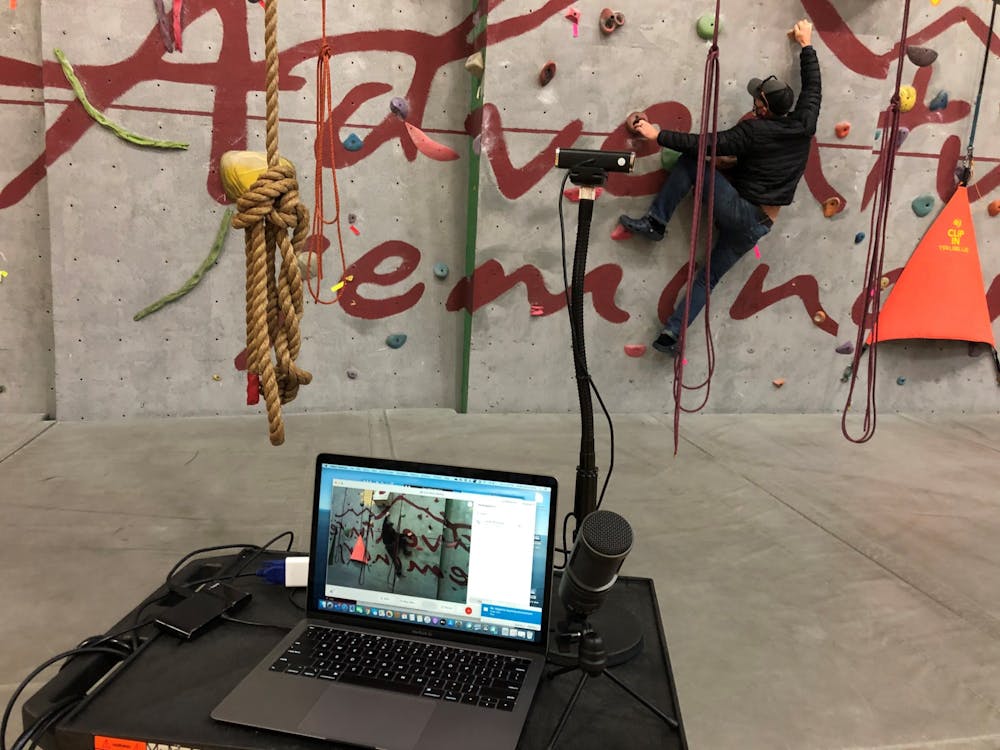Faculty adapts to declining in-person attendance

Department of Recreation, Parks and Leisure faculty member Jordan Bruursema demonstrates his class cart on Nov. 3, in Finch Fieldhouse. The cart is able to pick up close up images and sound from his rock climbing lab.
As the semester comes to end, attendance in Hyflex classes is drastically decreasing both in-person and online.
CMU has been committed to maintaining in-person class opportunities since the beginning of the fall semester. As on-campus COVID-19 cases rise and the semester progresses, faculty are seeing fewer students in person.
Provost Mary Schutten said in an email that data from the Academic Senate and Student Affairs staff shows declining attendance of both in-person and online classes. She said the administration is addressing the situation and providing necessary support to students through Student Affairs staff, academic advisors and faculty outreach.
In a message sent out to faculty on Oct. 12, Schutten told faculty if their in-person attendances are down, adjust by only offering in-person classes once a week or every other week. She also said they can wear a face shield with only 1-2 student in attendance and no face covering if the room is empty.
Jamie Brown, faculty member in the Department of Recreation, Parks and Leisure Services, said students in her classes quickly shifted their interest from wanting to attend face to face to only having one or two people.
“I have a first-year class that has stayed pretty much in-person," Brown said. "I started off thinking about 10 percent would (attend) online. That one class has stayed true, but the other classes it is more like 10 percent in class.”
Since the beginning of the semester, Brown said a few of her students contacted her saying they were uncomfortable attending in-person classes because of concerns about the spread of COVID-19.
Another struggle her students have expressed is having back-to-back classes offered online and then in person, making it difficult to travel to them if they live off campus.
As in-person attendance and the interests of students have declined this semester, faculty members are taking unique approaches to keep students engaged.
Tracy Galarowicz, a professor of Fisheries and Biology Management, knew the most important part of her class was getting her students to be able to hold a fish for themselves from Rose Pond and Chippewa River.
The first six weeks of class she had two different field trips with a couple students at a time. She then recorded lectures and labs for the students not attending the field trip that day. Galarowicz also welcomed guest speakers from all across the country into her online classrooms to speak to students about their future careers.
Despite finding ways of conducting hands-on learning, Galarowicz worries about the long term outcome of missed opportunities for students.
“In my particular area, it is a relatively small field," Galarowicz said. "Getting to talk to a student before class and getting to know their strengths and weaknesses was very helpful for me when it came to writing letters of recommendation or finding internships.”
Department of Recreation, Parks and Leisure faculty member Jordan Bruursema also found ways to continue hands-on activities. For his Outdoor Recreation classes, students utilize the rock climbing wall in Finch Fieldhouse for lab exercises to learn about safety, rescue, tying knots, climbing skills and facilitation skills.
Bruursema needed to be able to zoom in and out, move throughout different classroom spaces, see what was happening on the rock wall and pick up the voices of other students in class. In response, he created a cart to make online learning more immersive for students who could not attend in person.
The cart includes a standard microphone, camera, laptop, portable microphone and a Bluetooth speaker. This allows students to be involved wherever the professor or students go. The cart has gained recognition and is being passed around to different classrooms and faculty members as they teach their courses.
“Really why we wanted that cart was for somebody that can’t be here, to still feel like they are here,” said Bruursema. “They can still facilitate a group virtually even though they are just a little talking head on a screen, and they are still able to feel like they are a part of the experience that’s happening.”
Despite his class structure of hands-on learning, Bruursema said in-person attendance has continued to decline throughout the semester for his classes. Luckily, the cart has helped to keep up attendance online.
Bruursema said it is difficult to know why a student is missing class, whether it is a concern for their health or just because it is easier to stay online. Due to the nature of his courses, he continues to encourage his students to attend in person whenever possible.






